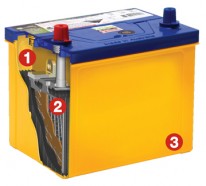 A battery is one of the most fundamental components that make a vehicle start and run smoothly. Unfortunately, although created to withstand severe conditions, not every brand is specifically designed to handle the extreme environment that motorists in Australia often experience. Hence, car batteries fail unexpectedly, especially in Sydney’s bumper-to-bumper peak driving environment.
A battery is one of the most fundamental components that make a vehicle start and run smoothly. Unfortunately, although created to withstand severe conditions, not every brand is specifically designed to handle the extreme environment that motorists in Australia often experience. Hence, car batteries fail unexpectedly, especially in Sydney’s bumper-to-bumper peak driving environment.
The country’s climate varies from place to place, but temperatures can rise from 25 to over 50 degrees centigrade in some areas. In a rough driving environment, temperatures like these could contribute directly to the breakdown of batteries’ physical components.
The warm Australian climate makes the battery’s electrolyte solution corrosive as it gets hotter. Due to this increased chemical reaction, the lead components are eaten away faster or react internally, causing sulphation layers on the plates, which inhibit electric current flow.
Car Batteries Fail Prematurely In Higher Under-Bonnet Temperatures
Basically, for every 10-degree increase in temperature, the car battery’s chemical reaction is doubled, thus causing a more corrosive “Acid Soup.” So naturally, this is more of a concern, especially in milder and hotter conditions such as those in Australia. So century Batteries undertook a study of under-bonnet temperatures in late model Ford Falcons and Holden Commodores in Sydney and Melbourne’s variable driving environments.
It was concluded that there was a range between 73 and 85 degrees within an ambient temperature range of 28 to 37 degrees. Another interesting fact was that cooler outside temperatures had little or no effect on cooling the hot under-bonnet temperatures. However, the statistics show that city driving in the hotter summer months increased the temperatures exponentially, thus increasing the battery’s corrosive nature.
To understand how essential it is to use only car batteries that are specifically designed for the Australian climate, here are some other top reasons why batteries suffer from premature damage:
Battery Acid Stratification
A common issue with city dwellers is the infrequent use of their vehicles. The result is the stratification of the battery’s acid due to under-charging, causing a heavy concentration to settle to the bottom of the internal battery case. The highly corrosive mixture exponentially increases the corrosion of the bottom sections of the plates, decreasing the battery’s longevity.
Corrosion
Batteries are subjected to high temperatures under the bonnet in many parts of Australia. With the heat, battery acid, which is already corrosive by nature, becomes increasingly so. It tends to eat away at the critical internal components of the batteries made from metal alloys. This then results in early internal damage and eventual car battery failure.
Water loss
It is natural for automotive batteries to lose moisture because of gassing, even in ideal conditions. But, just like a “Water Kettle”, as temperatures increase, the rate of gassing/evaporation also increases, and as a result, batteries lose water at a faster pace. The Century Sealed Maintenance Free Range is engineered with superior internal components and materials to minimize water loss in all conditions.
Vibration
Automotive batteries are subjected to strong vibrations when a car is used on rough roads. Vibration can cause damage to the internal components of the vehicle’s battery and can even lead to cracks and degradation of the active paste material on the plates. Unfortunately, the roads in Australia, which we are all very aware of, are not of the highest standard, and the vibration is a common problem.
Idling and city gridlock driving conditions
Idling, such as when the engine is allowed to run during traffic jams or when a vehicle is driven at slow speeds for long distances, can contribute to premature battery failure. The loads placed on a battery in these conditions are pretty extreme, causing irreparable damage.
Why does the robust construction of batteries matter?
Australia’s harsh weather and city gridlock driving conditions, combined with rough roads, can vibrate and stress critical components within a battery. Therefore, they should be designed for our conditions, with components able to withstand excessive corrosive effects and vibration resistance.
Exposure to the elements is unavoidable for most batteries, so motorists must choose the right kind of product specifically built for extreme conditions. We have been using our No1 imported brand Supercharge Batteries for over 15 years for longevity, power, and value for money.
Our choice for locally made is Century Batteries. This brand has been at the forefront for over 85 Years here in Australia, developing innovative batteries that meet the expectations and demands of motorists nationwide.
Keynote:
In conclusion, the rate at which car batteries fail exponentially increases with constant idling and stopping in gridlock city driving environments. In addition, under-bonnet temperatures and insufficient charging are dramatically increased in these conditions, increasing the battery acid’s corrosive nature, which degrades the internal components rapidly.
We highly recommend a great resource on common frequently asked battery questions. (Opens in new window)
Next Page: Battery Maintenance
